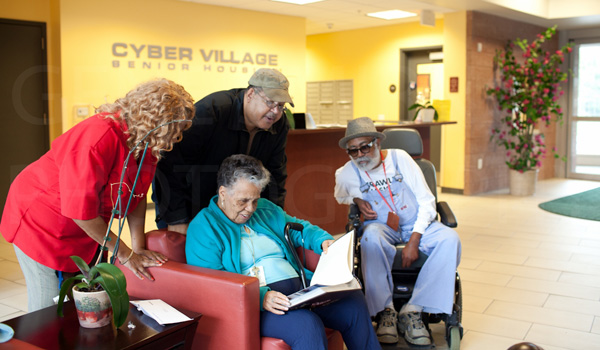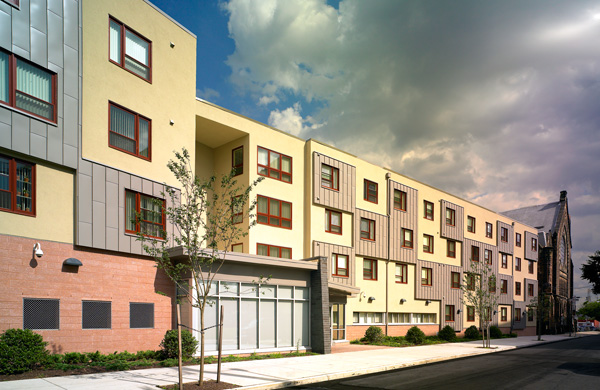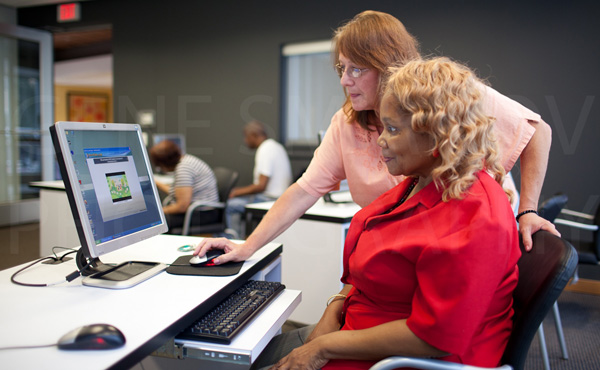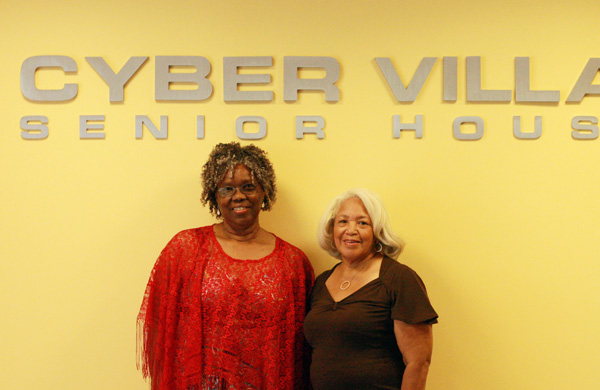 story by Liz PachecoThe yellow-painted halls of Mt. Tabor Cyber Village looks more like a college dorm than a senior living center. Apartments are decorated with welcome mats and doorhangers, and residents have personalized the individual shelves outside their doors. There’s a computer lab, fitness center and community room on the first floor. And each of the four floors boast a shared laundry area and common room where residents can read, play cards, watch TV or just hang out. Being 55 or older never looked more fun.
story by Liz PachecoThe yellow-painted halls of Mt. Tabor Cyber Village looks more like a college dorm than a senior living center. Apartments are decorated with welcome mats and doorhangers, and residents have personalized the individual shelves outside their doors. There’s a computer lab, fitness center and community room on the first floor. And each of the four floors boast a shared laundry area and common room where residents can read, play cards, watch TV or just hang out. Being 55 or older never looked more fun.
“[We have] a close-knit type of atmosphere here in this building,” says Mary Reese, who moved to Cyber Village in June 2009, six months after it opened. “I know everyone in the building and they know me.” Reese loves living here—it’s safe and well cared for, she says. “You couldn’t ask for a better place.”
The Cyber Village is a project of the Mt. Tabor African Methodist Episcopal Church, a fixture in the Philadelphia religious community. Founded in 1803, the church is still at its original location on North 7th Street, between Girard and Poplar Streets. In addition to regular religious services, Mt. Tabor provides outreach services, such as educational and after-school programs, activity days and prison inmate rehabilitation. While Mt. Tabor has many leaders, Rev. Martha Lang and Rev. Mary Moore spearheaded the Cyber Village project. Rev. Lang joined Mt. Tabor as pastor in 1983 and Rev. Moore arrived almost 10 years later, in 1992. They make a lively pair, full of joy and pride in their church community.
The initial idea for the Cyber Village came from what Rev. Lang describes as her vision. “I believe God gave me a vision to do something for the community to help bring it alive because this area was dying,” she says. Her vision was specifically directed at youth and seniors. A study by the Mt. Tabor Community Education and Economic Development Corporation (CEED) showed both groups as those most in need in their community.
“The neighborhood has been changing for the past several years,” says Richard Winston, the Cyber Village architect from BWA Architecture + Planning. “[It] had a pattern of empty lots… run-down housing. A fair percentage of the seniors were underserved.”
So Reverends Moore, Lang and Lang’s late husband, Rev. Larry Lang, worked with the Mt. Tabor CEED team to find a solution.
 “Their vision was to have an apartment building that would be loosely affiliated with Mt. Tabor Church, but stand on its own,” says Winston. With an empty lot on both sides of the church, adding an affordable housing center seemed viable. However, developing a plan was complicated and expensive. That’s when Rev. Moore reached out to the Collaborative. With the Collaborative’s help, a site plan and conceptual design were created in 2005. Five years later, the affordable housing for seniors center opened.
“Their vision was to have an apartment building that would be loosely affiliated with Mt. Tabor Church, but stand on its own,” says Winston. With an empty lot on both sides of the church, adding an affordable housing center seemed viable. However, developing a plan was complicated and expensive. That’s when Rev. Moore reached out to the Collaborative. With the Collaborative’s help, a site plan and conceptual design were created in 2005. Five years later, the affordable housing for seniors center opened.
Reverends Lang and Moore refer to it as “the miracle on Seventh Street.”
Before the Cyber Village, the empty lots were regularly abused by the neighborhood. “They were trashing it. We had to keep it clean. We had to remove the snow,” says Rev. Lang. “The city didn’t take care of it. We took care of it.”
Though they performed owner-like duties, the lots didn’t belong to Mt. Tabor, and no one was really sure who owned the land. Mt. Tabor began applying for ownership in 1999. Ten years and multiple disputes between the city and the Redevelopment Authority later, Mt. Tabor finally owned the space.
Acquiring the lot wasn’t the only major obstacle. To receive tax credits for an affordable housing building, the design had to pass specific requirements of the Pennsylvania Housing Finance Agency. Consequently, many elements of the Collaborative’s original conceptual design had to be altered.
“When we first came to the table, we wanted the first floor to be commercial,” says Rev. Moore. “We had wanted a little café and a doctor’s office, all to be convenient to the seniors.” But receiving tax credits for a commercial space wasn’t viable. The number of units was also reduced and other changes were made to the design.
 Most sustainable features were kept. The Cyber Village has a green roof, which is critical for stormwater management and provides insulation. The building is energy-efficient with Energy Star appliances, lighting and HVAC equipment, low-flow plumbing, and green materials used wherever possible.
Most sustainable features were kept. The Cyber Village has a green roof, which is critical for stormwater management and provides insulation. The building is energy-efficient with Energy Star appliances, lighting and HVAC equipment, low-flow plumbing, and green materials used wherever possible.
Another crucial design element was the “cyber village” theme. “[The Mt. Tabor CEED] expressed from the outset the vision of a community of older adults who are connected to the larger community through the use of technology,” says Winston. Residents are provided with their own laptops, and technology skills are taught in the first floor computer lab. Winston and the other architects even went so far as to include the theme in the building’s façade.
“This was one of those funny leaps that designers sometimes take,” says Winston. “We thought about digital technologies and then we thought about pixilation on your computer screens. We had this idea that if we used modestly priced materials and just a little bit of articulation, we could alternately push the façade in and out.”
The concept is modern, unusual and aesthetically pleasing, but looks nothing like the regal, stone-covered church next door. Despite the architect’s fears that the design might be too daring, the Reverends embraced the concept, which Winston attributes to the project’s overall goal: providing a modern place for older adults who are independent and still an active part of the community.
Even with those early obstacles, the Reverends describe the design and construction process as very smooth. “Usually, when you’re building anything, there’s always different conflict,” says Rev. Lang. “We had none of that.”
 Rev. Moore chimes in, revealing the secret to their success. “Pastor Lang brought this faith…always praising God and saying Hallelujah. They went from cursing to Christ!”
Rev. Moore chimes in, revealing the secret to their success. “Pastor Lang brought this faith…always praising God and saying Hallelujah. They went from cursing to Christ!”
With the Cyber Village complete, the Reverends are looking ahead. Winston is helping them put a sitting garden behind the housing center, where residents and the local youth organization Teens 4 Good will have a vegetable garden. And there are more construction plans. Eventually, the other empty lot will become the Mt. Tabor Intergenerational Community Recreation and Education Center—a place specifically for youth.
“The people that were displaced and… have come from other areas of the city, they love it here. They found a home,” says Rev. Lang. “All the things we had dreamed and hoped for and worked hard for, they were realized with the people that are here.”


